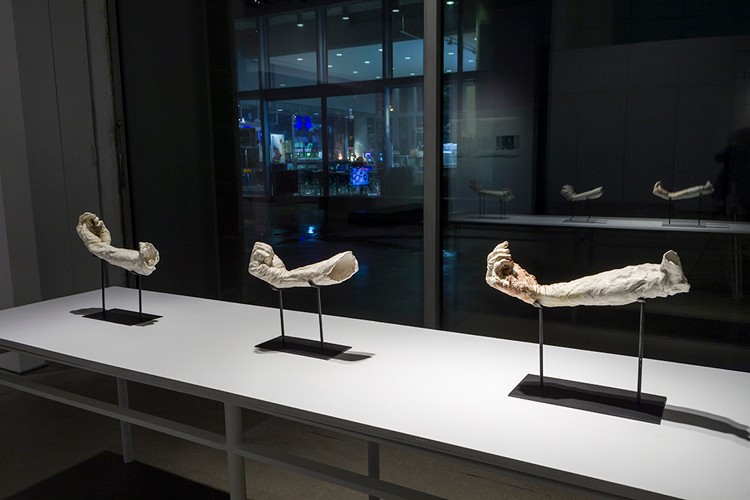COMBINE 2012: Annual Undergraduate Student Exhibition
Author: Adrienne Johnson
Artist: Melodie Reay
 Melodie Reay, Hands, 2012, ceramic sculpture, human scale, variable. Photo: Guy L'Heureux
Melodie Reay, Hands, 2012, ceramic sculpture, human scale, variable. Photo: Guy L'Heureux
About the artist
“Phantasies of dismemberment are a burden that all self-aware membered creatures bare... and the ‘lines of fragilization’ are drawn within the human body by all those who inhabit one.”
—Malcolm Bowie, Lacan
According to French scholar Malcolm McNaughtan Bowie’s (1943-2007) analysis of Jacques Lacan’s (1901-1981) writings on the psychoanalytical construction of the ego and anxiety of the ”fragmented body,”1 the mirror stage, occurring during infancy, is the earliest moment of self-awareness, triggered upon beholding one’s reflection and actions in a mirror. This, Lacan posits, creates a continuous memory that the individual is perpetually threatened by disunity or fragmentation.2 Whether physically, psychologically or emotionally, the notion of not being whole, sound and complete is a persistent concern of the human condition.
In Hands by Melodie Reay, the viewer is presented with a series of fragmented appendages of the human body. As part of her ongoing exploration of the human as a body as an unveiling of time, age, and experience, Reay focuses on a trio of distinct, ceramic clay sculptures of human hands in the round. The well-worn hands remind us of the many of ways these intricate tools serve our reality, informing how we perceive, navigate and interact with our environment.
The malleability of clay, both in its vulnerability and resilience, creates a strong allegorical connection between material and subject. Assiduously modeled by hand in slabs and coils, the clay is pushed and pulled by Reay to its limit to generate as much texture as possible and to “evoke the sense of flesh at the mercy of gravity.” Completely hollow, the fragility of the pieces—and the implied relationship to the human experience—is palpable.
The disembodied hands belong to no one and everyone. Their realistic and expressionistic characteristics, ranging from determination to despair, remain open to interpretation. From the series of six, one is modeled from the wrist, the fingers rest listless and without tension. A second is modeled from mid-forearm to fingertip, veins protruding, fingers clenched, and skin deeply pleated, constructed as though from the stresses of time and experience. Another shows the hand twisting outward and bends inward as though the musculature is unnaturally contorted.
Both material and subject remind us of the ephemeral nature of existence, the cycle of renewal and decay—of the earth and return to the earth.
Biographies
Adrienne Johnson
Adrienne Johnson (Montreal, Qc.) is completing her BFA in Art History, Concordia. She is a founding Coordinator of Concordia’s Ethnocultural Art Histories Research (EAHR) – a student research workgroup that engages with ethnocultural art histories research across various disciplines. With a view to honoring and contributing to the enrichment of our shared multicultural identity, a passionate area of interest for her is the re/presentation of Black Canadian art production in Canadian pedagogy and museums.
Melodie Reay
Melodie Reay is in her final year of a BFA in ceramics and photography. Transience, obsolescence and ritual are common themes in her work, which often places emphasis on the materiality and fragility of her chosen subject and medium. Her most recent work explores these ideas in relation to the human body in ceramic figurative sculpture.

